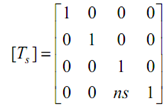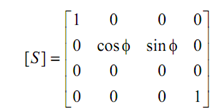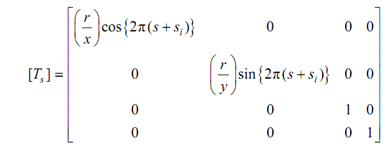Sweep Surfaces:
A three-dimensional surface is also attained by traversing an entity, for example a line, polygon or curve, along with a path in space. The resulting surfaces are called as sweep surfaces. Sweep surface generation is often utilized in geometric modelling. The simplest sweep entity is a point. The result of sweeping any point along with a path is, of course, not a surface but a space curve. Though, it serves to illustrate the fundamental technique.
Let the position vector P [x y z 1] swept along with the path represented by the sweep transformation [Ts]. The position vector Q (s) representing the resulting curve is
Q (s) = P [Ts] s1 ≤s < s2 -------- (16)
The transformation [Ts] find out the shape of the curve. For instance, if the path is a straight line of length n parallel to the z-axis, then

0 ≤ s ≤ 1
If the path is an origin-centered circle in a z = constant plane, then (see in below Eq.)

According to this

0 ≤ s ≤ 1
whereas si = (1/2π) tan-1 (yi/xi) and for P [x y z 1], r =  . Here, the subscript i is utilized to mention the initial or begining point.
. Here, the subscript i is utilized to mention the initial or begining point.